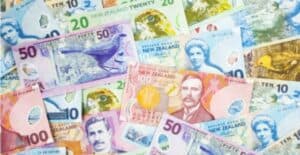The New Zealand dollar (NZD), which is also used as legal money and the national currency of the Cook Islands, Niue, and Pitcairn Islands, is the official currency of New Zealand. It was first used in 1967 and resembles Australian money in that one dollar is divided into 100 cents.
The one-dollar coin with the image of the native kiwi bird on its reverse is sometimes referred to as the “kiwi dollar” informally.
There are ten different denominations that makeup New Zealand’s money, distributed across five coins and five banknotes. Although there were formerly smaller denominations, the 10-cent coin has the lowest denomination. Due to rising production costs and inflation, these were discontinued. Coin values in New Zealand are 10, 20, and 50 cents, as well as $1 and $2, and notes have values of $5, $10, $20, $50, and $100.
$100 NOTE
Beginning at the top! The $100 bill is our largest denomination currency. Good on you if you’re fortunate enough to have several of these in your wallet! These aren’t used as frequently as other high-value bills, but when you do, you’ll notice an intriguing historical figure on the front.
That person is Lord Ernest Rutherford of Nelson, a physicist who was born in New Zealand and is frequently referred to as the “father of nuclear physics.” He was the first to split the atom. His research on the chemistry of radioactive compounds and the finding of radioactive half-life earned him numerous scientific honors, including the Chemistry Nobel Prize.
The fact that each note in the New Zealand currency has a different local bird is another amazing element. The Mohua, Yellowhead, a little bird that is unique to New Zealand and can only be found on the South Island, is depicted on the $100 bill.
The Caitlins National Reserve in the southeast corner of the South Island is where you may find this bird the most frequently. This bird would have been common throughout the 19th century, but imported species of rat have caused a severe reduction in the species.
A photograph of the Eglinton Valley, which is in Fiordland on the way to Milford Sound, can be seen in the note’s background. On our journey to the South Island, we stop here for photos, and it’s unquestionably a worthwhile item to cross off your bucket list in New Zealand.
$50 NOTE
Our next note is the $50 bill that fills the gap between the $100 and $20 bills. A portrait of Sir Apirana Turupa Ngata, a Maori politician and attorney who served in parliament for 38 years, may be seen on the front.
In his early years, he became the first Maori to graduate from a New Zealand university and the first person from New Zealand to earn two degrees from the same institution. He began to establish a reputation in politics and was active in the creation of legislation that would enhance the legal rights of Maori.
He played a significant role in efforts to preserve Maori culture through song, sport, the construction of gathering places, and the promotion of the Maori language.
The Kokako, a native bird of both the North and South Islands of New Zealand, is also depicted on this bill, though it is thought that the South Island Kokako is extinct. The Te Urewera National Park on the North Island is home to the majority of the species’ estimated 400 breeding pairs, which makes it an endangered species.
The Pureora Forest, one of the North Islands’ largest expanses of native forest, may be seen in the background of the notes. This forest is home to a wide variety of native plants and animals.
$20 NOTE
Even though New Zealand has been an independent nation for a long time, many aspects of New Zealand culture still stem from its period as a British colony. Queen Elizabeth II is shown on the $20 bill. Since 1952, Queen Lizzy has served as the monarch of both Britain and New Zealand, but she has no influence over the political or decision-making processes in any nation.
The British were undoubtedly a large part of New Zealand’s history, which is why the Queen is still depicted on the coinage despite the British Empire’s clear significant disintegration through time into the Commonwealth of Nations and ultimately seeing several countries gain independence.
There is a picture of a Karearea, New Zealand Falcon on the back of the note. The sole native diurnal (awake during the day) raptor in New Zealand. It is sometimes confused for the more widespread Swamp Harrier and is the most endangered bird of prey in the nation. They are less frequent in the northern region of the North Island and more frequent on the South Island.
The New Zealand Parliament buildings and Queen Elizabeth may be seen in Wellington in the background of this note, while Mt. Tapuaenuku, the South Island’s tallest peak and a 2885 m tall mountain, can be seen next to the Karearea.
$10 NOTE
New Zealand became the first nation to grant women the right to vote in 1893. Kate Sheppard was the most renowned member of the Women’s Suffrage movement. She fought for women’s suffrage for many years, and her efforts had a significant impact on suffragette organizations around the world. She is therefore included on the $10 bill, as can be seen.
The Whio, Blue Duck is depicted on the back. Another indigenous bird to New Zealand, this one’s name, which is pronounced “fee-oh,” refers to its call. Although there are a few well-funded efforts to manage these populations and increase their numbers, the species is another that is threatened by invasive species.
$5 NOTE
Magnificent New Zealand outdoors and Sir Edmund Hillary, one of the most well-known New Zealanders and the first person to climb Mount Everest in 1953, are both honored on the $5 bill. Long before he set his sights on Everest, he was an experienced mountaineer and explorer who trained for his climb of Everest on mountains in New Zealand.
In addition, he was the first person to ascend Mount Everest and reach the North and South Poles. After conquering Everest, he founded the Himalayan Trust to aid Nepalese families. As a result of his accomplishments, Time magazine listed him among the top 100 most influential individuals of the 20th century.
COINS! $2, $1, 50C, 20C & 10C
There are five different sizes of New Zealand coins, and each one has a distinctive engraving. All of the coins feature Queen Elizabeth II; like the $20, this is a holdover from New Zealand’s colonial era, but the front of the coins features only New Zealand-related imagery.
The Great White Egret, sometimes known as the Kotuku in New Zealand, is seen on the $2 coin. It is a widespread bird in Australia and other Asia-Pacific regions, but it can only be found on New Zealand’s West Coast, where its breeding grounds are located on the Okarito Lagoon. While traveling up the West Coast of the South Island, we stop in the little hamlet of Okarito, where it is possible to witness the Kotuku. Even though this is its only breeding area, it is still quite uncommon.
The iconic Kiwi bird from New Zealand appears on the $1 coin. The fuzzy, flightless bird has gained worldwide recognition and becomes a symbol of New Zealand, thus it is prominently displayed on our $1 coin.
Our 50-cent coin features a picture of the vessel The Endeavour. Captain James Cook was in command of the HMS Endeavour during his exploration of Australia and New Zealand between 1769 and 1771.
The 10c coin features a carved Maori head known as a Koruru, while the 20c coin features a well-known Maori carving of Chief Pukaki.
Conclusion
NZD is a liquid currency in forex markets as one of the most traded currencies globally. When compared to GDP, New Zealand has a high FX turnover because of international traders looking for yield, the fact that many banks and companies there are owned by foreign firms, which leads to currency swaps to reduce FX risk, the fact that exports and imports account for a sizable portion of the country’s GDP, and the fact that New Zealand businesses and organizations borrow heavily from foreign markets.





